Table of Contents
Leukemia is a serious malignancy affecting blood and bone narrow. The cancer is characterized by an abnormal and excessive proliferation of white blood cell precursors blocked at the stage of differentiation. Those immature blood cells turn into malignant cells and invade blood and bone marrow. This hematological disorder leads to inadequate production of red blood cells, a decreased white blood cell count, and low platelet count (thrombocytopenia).
Although rare, leukemic cells can also invade other organs such as your lymph nodes, spleen, liver, testes, or central nervous system (CNS). Depending on the severity of the disease, leukemia can be acute or chronic and take many forms. The most common forms of leukemia include:
- Acute lymphoblastic leukemia (ALL)
- Acute myeloid leukemia (AML)
- Chronic lymphocytic leukemia (CLL)
- Chronic myeloid leukemia (CML).
Leukemia Statistics
Leukemia is very common all over the world and accounts for about 3% of a million cancer deaths. In the United States alone, about 265,000 people live with leukemia. According to the American Cancer Society, it is estimated that 44,790 men and women (25,630 men and 19,160 women) were diagnosed with leukemia in 2009; nearly 21,870 men and women died of it.
The incidence however, varies by age and sex. From 2002-2006, the median age at diagnosis for leukemia was sixty six years of age; thus, the percentages and ages of people diagnosed were approximately:
11.1% were under age 20
4.7% between 20 and 34
5.5% between 35 and 44
10.1% between 45 and 54
15.0% between 55 and 64
19.8% between 65 and 74
23.3% between 75 and 84
10.5% 85+ years of age
Leukemia Causes
Apart from intensive occupational exposure to certain chemicals that are known factors for acute leukemia or chronic myeloid leukemia, the causes of the disease remain unknown. However, there are some theories:
- Benzene – Prolonged exposure to this organic chemical compound can cause leukemia in children. Studies have shown that children living close to gas stations or any place where fuel for vehicles is sold, have four times more risk of developing leukemia than other children do.
- Certain Foods – Studies have been conducted on hot dogs by many scientists such as Sara and David A. Sarasua Savitz of the University of North Carolina at Chapel Hill. They found that children who eat more than twelve hot dogs per month have about nine times more chances of having leukemia.
The problem lies in the ingredients contained in hot dogs. Hot dogs contain a form of salt called nitrite that can also be found in some vegetables. In its natural form, nitrite is not harmful to your body. However, during the cooking process, nitrites combine with certain amines naturally present in meat to form “N-nitroso”, a highly potent carcinogen agent.
- Tobacco – Tobacco has always been known as the number one cause of oral cancer. Although it is not clear, it seems that regular use of tobacco increases the risk of acute myeloid leukemia in adults. According to the Canadian Council for Tobacco Control,tobacco use (including chewing of tobacco and cigarette smoke) seems to participate in development of plasma cell myeloma and acute myelogenous leukemia.
- Ionizing radiation – Numerous studies have shown that the risk of leukemia is two times higher among individuals who are constantly exposed to ionization radiation. In addition to leukemia, ionization radiation can also cause other types of cancer such as skin cancer.
- Genetic – In most patients with myeloid leukemia, scientists have found an abnormality in chromosome 22 called Philadelphia chromosome or Philadelphia translocation. This disorder occurs in almost all cases of chronic myelogenous leukemia, which leads to the belief that genetics can play a role in having leukemia.
- Virus – Certain viruses such as Human T-lymphotropic virus appears to play a role in the occurrence of leukemia; this assumption, however, remains controversial.
Leukemia Symptoms

The onset of leukemia is often asymptomatic; in fact, the majority of patients do not suspect any clinical signs characteristic of the disease. They learn they have leukemia during a blood test or medical exam done for another medical condition. When the disease becomes chronic, leukemia symptoms may include:
weight loss
decreased appetite
fever or chills
shortness of breath
bone pain or tenderness
excessive night sweats
easy bleeding or bruising
enlargement of the spleen (splenomegaly)
joint pain (arthralgia)
liver enlargement (hepatomegaly)
weakness and fatigue
physical weakness and loss of strength (asthenia)
small red spots in your skin (petechiae)
Leukemia Diagnosis
Along with a physical exam, many tests and medical exams are used to diagnose leukemia:
- Physical exam – This is a simple exam during which your physician will search for signs and symptoms of leukemia like pinprick bleeds, bruises, skin paleness (due to anemia), and swollen lymph nodes.
- Blood tests – Your doctor may take your blood sample for laboratory analysis. In general, a high concentration of immature white blood cells and an abnormally low number of red blood cells and platelets is an indication of leukemia.
- Immunophenotype – This test is a powerful tool in the diagnosis and monitoring of most hematological malignancies such as lymphoblastic leukemia and myeloblastic leukemia. It helps to discover not only leukemia cells, but also to differentiate chronic lymphocytic leukemia cells from other types of leukemia and lymphoma.
- Cytogenetic analysis – This cytogenetic exam is a study of genetic phenomena in the chromosomes in order to detect Philadelphia chromosome. In rare cases, the Philadelphia chromosome is not present although there is leukemia. The most common techniques of cytogenetic analysis include karyotype analysis, Fluorescent In-Situ Hybridization (FISH), and DNA microarray analysis (DNA chip).
- Bone marrow biopsy – Your doctor can recommend a bone marrow biopsy to confirm the diagnosis and determine the type of leukemia you have. In general, the specialist will use a needle to withdraw a marrow sample and then analyze it under a microscope to look for leukemia cells.
Leukemia Treatment
Your oncologist will consider your age and type of leukemia in order to recommend an appropriate treatment. Leukemia treatment is generally less intensive in patients over sixty years old.
Chemotherapy
In many cases, chemotherapy in the treatment of chronic lymphocytic leukemia is unnecessary. Mild chemotherapy can be used to reduce the number of white blood cells and reduce the size of the lymph nodes and spleen.
Treatment of acute, myeloid, and lymphoid leukemia is based on Anti-mitotic Drugs (anti-mitotic chemotherapy); certain substances that are often used in the chemotherapy of these types of leukemia include vincristine and vinblastine. Those medications inhibit mitotic cellular division, and prevent the damage of the disease in the body. However, the treatment destroys not only the tumor cells, but also the normal cells in your bone marrow, which makes you susceptible to infections, bleeding, and anemia. A bone marrow transplant may also be considered. Sometimes the therapy requires prolonged hospitalization.
When detected early, certain types of leukemiacan be treated effectively with chemotherapy drugs. However, chemotherapy is a systemic treatment that affects both healthy cells and cancer cells, often leading to side effects. Adverse effects vary from one person to another depending on the drugs used and their dosage.
Chemotherapy Side Effects
All anti-cancer drugs affect cell division and the immune system (white blood cells). This is why cancer patients are more prone to infections during treatment like anemia, fatigue, hair loss, nausea and vomiting, intestinal disorders, or even lesions in the mouth (mucositis).
Radiotherapy (Radiation Therapy)
Radiation therapy is a regional treatment consisting of using ionizing radiation to kill leukemia cells. It can be administered externally (external beam radiotherapy) or internally (brachytherapy or internal radiation therapy). Your oncologist will use the method that he thinks can be more effective to treat your condition. Although rare in the treatment of leukemia, both external beam radiotherapy and internal radiation therapy can be used.
Radiation Therapy Side Effects
Radiotherapy can be effective in some types of leukemia; however, it tends to cause severe blood changes including a drop in production of new blood cells, nausea, anemia, vomiting, and other short/long-term side effects.
Immunotherapy (Biological Therapy)
Immunotherapy is a cancer treatment aimed at stimulating the natural defense of the body (the immune system) to fight against leukemia cells and destroy them. Several molecules are currently used in leukemia immunotherapy; the most common are kinase inhibitors: Imatinib, Dasatinib, Nilotinib and Bevacizumab.
Stem Cell Transplant
This method consists of replacing leukemic cells with healthy cells, which can be either from your own healthy cells (autologous stem cell transplant) or from a healthy donor (allogeneic stem cell transplant). The stem cell transplant is often used in case of failure of other treatments like chemotherapy, radiotherapy, and immunotherapy.
Bone Marrow Transplant
This is a complex medical procedure consisting of replacing leukemic marrow with leukemia-free marrow (healthy bone marrow). Your own marrow can be used (autologous transplant) or it can be that of an individual who does not have leukemia (allogeneic transplant). Bone marrow transplants are commonly associated with massive doses of chemotherapy and / or radiation. Although bone marrow transplant is a serious medical intervention, it often brings good result in the fight against leukemia.
Leukemia Prognosis
The prognosis for leukemia depends on several factors: age, stage of the cancer or organs affected, and the state of health of the patient. The sooner you are diagnosed with leukemia the more likely you are to survive. In addition, your survival chance depends on the type of leukemia that you have. For example, nearly 60% of patients with myeloid leukemia can be cured with a bone marrow transplant; 50-60% percent of young patients with acute lymphatic leukemia can be cured by chemotherapy. However, when it comes to leukemia, chances of recovery are much more favorable in children.
Survival rates also vary by race and sex. The overall five-year relative survival rate for 1999-2005 from 17 SEER geographic areas was 53.1%. Five-year relative survival rates by race and sex were:
53.8% for white men
53.0% for white women
45.5% for black men
46.1% for black women
Leukemia Prevention
Since the causes of leukemia are not well known, it is not easy to establish preventive measures. While it is not always possible to prevent cancer, you can reduce your risk.

To prevent the occurrence of all cancers including leukemia, it is important to live a healthy lifestyle and live in a healthy environment. An unhealthy environment (including workplace) can promote the formation of cancerous cells in your body.
Some risk factors such as age, sex, and genetics are impossible to change, but the following causative factors can be prevented:
- Avoid tobacco smoke, including second hand smoke.
- Maintain a healthy weight.
- Limit your alcohol intake.
- Reduce your exposure to toxic chemicals.
- Reduce your exposure to ultraviolet (UV) radiation.
- Exercise regularly.
- Practice safe sex.
- Keep your immune system healthy.
- Tell your doctor or dentist of any change that indicates the presence of cancer.
- Adopt a healthy diet: a diet containing 5-10 servings of fruits and vegetables a day may help prevent the occurrence of many cancers, including leukemia. Increase the following foods in your diet:
- a) avocados
- b) blueberries
- c) black Raspberries
- d) curcumin
- e) flax
- f) garlic
- g) papaya
- h) pomegranate juice
- i) tomatoes
- j) soy products
- k) grapefruits, oranges and other citrus fruits
- l) cruciferous vegetables (broccoli, cauliflower, kale, Brussels sprouts, and cabbage)



